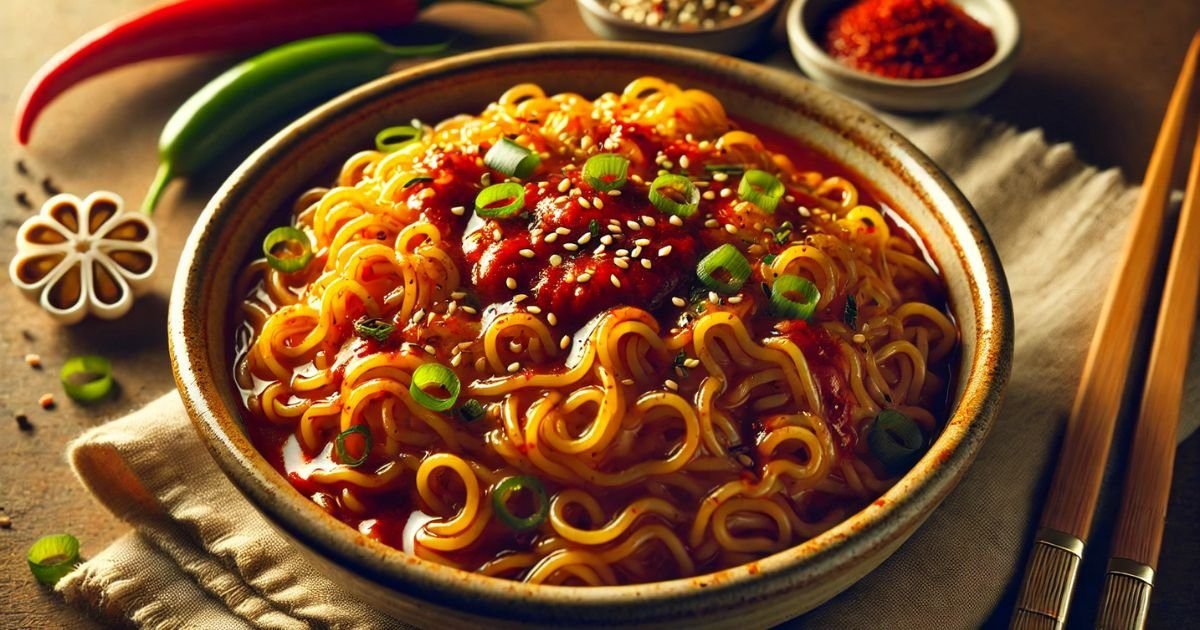Gochujang Buttered Noodles is a flavorful dish that combines the heat of gochujang, a popular Korean chili paste, with the rich, creamy texture of buttered noodles. This dish is perfect for those who crave a blend of spice and comfort in their meals. The creamy butter helps balance the heat from gochujang, creating a harmonious flavor profile that is both satisfying and unique. Whether you’re a fan of Korean cuisine or simply love trying new, bold flavors, Gochujang Buttered Noodles is a must-try. The simplicity of the recipe makes it easy to prepare while still delivering an unforgettable taste experience.
What Are Gochujang Buttered Noodles?
Gochujang Buttered Noodles is a delectable dish that combines the bold and spicy flavors of gochujang, a Korean chili paste, with the rich creaminess of buttered noodles. This fusion creates a perfectly balanced combination of heat, savory depth, and smooth texture that makes the dish a standout choice for anyone craving something exciting yet comforting. The gochujang adds a tangy spice, while the butter helps tone it down, providing a smooth and luscious coating for the noodles. Traditionally served in Korean cuisine, this dish has been embraced worldwide due to its simplicity and ability to satisfy a range of taste preferences.
The beauty of Gochujang Buttered Noodles lies in its versatility. You can customize the level of spiciness by adjusting the amount of gochujang, making it suitable for both spice enthusiasts and those who prefer a milder flavor. Whether enjoyed as a quick weeknight meal or served at a gathering, it offers a unique and memorable flavor profile.
Step-by-Step Guide to Making Gochujang Buttered Noodles
Ingredients
- 200g noodles (ramen, spaghetti, or your preferred type)
- 2 tablespoons gochujang (Korean chili paste)
- 2 tablespoons butter
- 1 tablespoon soy sauce
- 1 teaspoon sugar (optional)
- 2 cloves garlic, minced
- 1 tablespoon sesame oil (optional)
- Garnish with sesame seeds and finely chopped green onions.
Instructions
- Cook the Noodles:
Boil the noodles according to the package instructions. Drain the noodles, reserving a small amount of pasta water for later use.
- Prepare the Sauce:
In a large pan, melt the butter over medium heat. Stir in the minced garlic and cook for about 1 minute until it becomes fragrant.
- Add Gochujang:
Stir in the gochujang and cook for an additional 2 minutes, allowing it to combine with the butter and garlic.
- Combine Noodles with Sauce:
Add the cooked noodles to the pan, tossing them in the sauce until they are fully coated. If the sauce is too thick, stir in a little reserved pasta water.
5. Finish the Dish:
Mix in soy sauce and sesame oil to enhance the flavor. Toss everything together until well mixed.
- Garnish and Serve:
Finish by sprinkling sesame seeds and chopped green onions on top as a garnish. Serve hot and enjoy!
Variations of Gochujang Buttered Noodles
Gochujang Buttered Noodles offers a lot of room for customization, making it a versatile dish for various preferences. For those following a plant-based diet, a vegan version of Gochujang Buttered Noodles can be easily made by substituting butter with plant-based alternatives like vegan butter or olive oil. Additionally, tofu or tempeh can replace meat for protein, while still maintaining the dish’s creamy, spicy characteristics. For spice enthusiasts, the dish can be made even hotter by adding extra chili flakes or sliced fresh chilies along with the gochujang, creating a fiery experience.
Those who prefer a milder flavor can reduce the amount of gochujang and add a little more butter for extra creaminess. For a more substantial meal, adding grilled chicken, beef, or shrimp can transform Gochujang Buttered Noodles into a hearty main dish. This flexibility ensures that everyone can enjoy this dish tailored to their tastes and dietary needs.
Common Mistakes to Avoid When Making Gochujang Buttered Noodles
Overcooked noodles become mushy and absorb too much sauce, ruining the texture of the dish. Be sure to cook the noodles al dente to maintain their firmness and perfect texture when mixed with the sauce.
Adding too much gochujang can make the dish overly spicy, while too little can result in a bland taste. It’s essential to find the right balance to ensure the flavor is bold but not overwhelming. Adjust based on personal spice tolerance.
If the noodles aren’t tossed well enough in the sauce, they won’t absorb the full flavor. Make sure to stir the noodles thoroughly in the sauce to ensure every bite is coated evenly.
Some ingredients like gochujang and butter are essential for the authentic taste of the dish. Avoid substituting them with other sauces or oils unless you’re making a specific variation, as it may alter the intended flavor.
Must Read : Faqlogin.com Home Improvement: Increasing Home Value
Pairing Gochujang Buttered Noodles with Other Dishes
Pairing Gochujang Buttered Noodles with complementary side dishes can elevate the overall meal experience. For a balanced meal, consider serving it with kimchi, the fermented Korean side dish that adds a tangy, spicy contrast to the rich, buttery noodles. The acidity and crunch of kimchi help balance the creaminess of the noodles, creating a harmonious combination. You can also pair the dish with a light salad to add freshness, such as a simple cucumber or mixed greens salad with a vinaigrette dressing to cut through the richness of the noodles.
If you’re looking to add protein, grilled chicken, shrimp, or tofu are excellent choices that pair well with the spicy noodles. For beverages, a chilled green tea or a light beer complements the heat and richness, offering a refreshing contrast. These thoughtful pairings enhance the flavors of Gochujang Buttered Noodles while creating a satisfying, well-rounded meal.
5 FAQs About Gochujang Buttered Noodles
Can I make Gochujang Buttered Noodles ahead of time? Yes, you can prepare the noodles and sauce in advance, store them separately in the fridge, and reheat when ready to serve. The noodles may absorb some of the sauce during storage, so you may need to add a little water or butter to loosen the sauce when reheating.
How spicy are Gochujang Buttered Noodles? The spice level can be adjusted based on the amount of gochujang used. For a milder dish, use less gochujang, or opt for a mild version of the paste. For more heat, you can add extra gochujang or other chili-based ingredients.
Can I use any type of noodles for Gochujang Buttered Noodles? Yes, you can use various types of noodles, such as ramen, spaghetti, or udon, based on personal preference. Just be sure to cook them properly for the best texture.
How can I make Gochujang Buttered Noodles more creamy? You can make the dish creamier by adding a small amount of heavy cream or milk to the sauce. Alternatively, using more butter will also increase the creaminess of the dish.
Can I freeze Gochujang Buttered Noodles? While it’s best to enjoy Gochujang Buttered Noodles fresh, you can freeze the sauce separately. The noodles may become a bit soft upon reheating, so it’s recommended to store the noodles and sauce separately if planning to freeze.
Final Words:
Gochujang Buttered Noodles is a deliciously unique dish that brings together the perfect balance of spice, creaminess, and savory flavors. This versatile recipe allows you to customize the level of heat and add various proteins or vegetables, making it a meal suitable for any occasion. Whether you enjoy it as a comforting weeknight dinner or as a special dish to impress guests, Gochujang Buttered Noodles will surely satisfy your cravings for bold and rich flavors. The simple yet flavorful ingredients make it easy to prepare, while the combination of gochujang and butter creates a deeply satisfying taste.
With the flexibility to adjust the spice level and add toppings of your choice, this dish can easily cater to different tastes and preferences. If you’re looking for a new and exciting noodle dish to try, Gochujang Buttered Noodles is the perfect choice to bring a burst of flavor to your kitchen.
Read More : Magnesium Oxide vs Glycinate: Comparing Absorption, Benefits, and Uses
Thanks for visiting Globalexpressinfo.com. Don’t forget to share it on Twitter.






